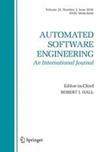Data-driven prototyping via natural-language-based GUI retrieval
Abstract
Rapid GUI prototyping has evolved into a widely applied technique in early stages of software development to facilitate the clarification and refinement of requirements. Especially high-fidelity GUI prototyping has shown to enable productive discussions with customers and mitigate potential misunderstandings, however, the benefits of applying high-fidelity GUI prototypes are accompanied by the disadvantage of being expensive and time-consuming in development and requiring experience to create. In this work, we show RaWi, a data-driven GUI prototyping approach that effectively retrieves GUIs for reuse from a large-scale semi-automatically created GUI repository for mobile apps on the basis of Natural Language (NL) searches to facilitate GUI prototyping and improve its productivity by leveraging the vast GUI prototyping knowledge embodied in the repository. Retrieved GUIs can directly be reused and adapted in the graphical editor of RaWi. Moreover, we present a comprehensive evaluation methodology to enable (i) the systematic evaluation of NL-based GUI ranking methods through a novel high-quality gold standard and conduct an in-depth evaluation of traditional IR and state-of-the-art BERT-based models for GUI ranking, and (ii) the assessment of GUI prototyping productivity accompanied by an extensive user study in a practical GUI prototyping environment.


 求助内容:
求助内容: 应助结果提醒方式:
应助结果提醒方式:


